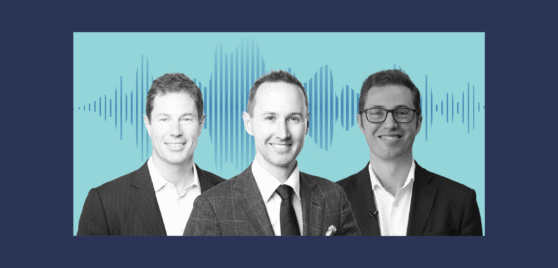Featuring Simon Conn
LISTEN
READ
2024 was another strong year for share markets and for IML’s small and mid cap funds. In this podcast Simon Conn, IML Senior Portfolio Manager, discusses how IML’s small and mid cap funds performed during the final quarter of 2024 including the performance of key stocks.
Follow our podcast, ‘Navigating the Noise’ on Spotify, Apple or Amazon to be notified of new episodes.
 |
 |
 |
Lightly edited transcript – Recorded on 13 January
Jason Guthrie – Hello and welcome to Navigating the Noise, a podcast by Natixis Investment Managers Australia, where we bring you insights from our global collective of experts to help you make better investment decisions.
I’m your host, Jason Guthrie, and today I’m joined by Simon Conn for a recap of the last quarter of 2024 and to hear his expectations for the year ahead. Now, Simon is a regular on these podcasts. He has almost 30 years in markets. He’s a senior portfolio manager at IML for the small and mid-cap team, working closely with the other portfolio managers in the team, Marc Whittaker and Lucas Goode.
Welcome back, Simon, and Happy New Year! I know this is one of your favourite times of the year with the Aussie Open kicking off.
Simon Conn – Yes, always an enjoyable time of year, Jason. Thank you very much. Thanks for having me back on the podcast.
Jason – So getting right into the quarterly update, like the large caps, the smaller end of the market also had a bit of a sell-off in December. But overall, it was a pretty solid year for equities and particularly for your funds. Congratulations to the team. Now I know clients and investors really appreciate the strong, but importantly, very consistent outcomes delivered by the team. What were some of the main developments in the small and mid-cap market, and what do you think investors should really be aware of?
Simon – Yeah. Thanks, Jason. Look, I think what we sort of witnessed in the small cap market was a bit of what we witnessed in the large caps. There’s been a melt-up in particular sectors. Investors are gravitating towards certain stocks or themes and bidding up those stocks. So, you know, we’ve seen over the years stocks like Pro Medicus, Technology One, and Life 360 in the small sector doing very strongly.
So those stocks leverage technology and are basically businesses with high gross margins that can grow potentially fast. They’ve been bid up, and any positive news leads to a rewriting of the stock almost regardless of the price – a bit like what we’ve seen with CBA in the large caps. So that again was a theme in the small caps, but you know, we’re pleased that the portfolios performed well despite that in pushing up the index.
Jason – And what did that performance look like, particularly in that last quarter? I know, depending on the fund in small and mid caps, you were able to generate between 15% and 20% for the full calendar year. But what was the last quarter like?
Simon – For the last quarter, we did between 1% to 2%. So Future Leaders was just plus 0.9%, and the IMSC, the Smaller Companies Fund, was plus 2% for the last quarter of the year, which is a pleasing outcome given that the indexes were down for that quarter.
Jason – And turning to some of the specific companies, Simon, what were some of the standouts for the team? Have you added any new names to the portfolio in the quarter?
Simon – Look, I think one of the things just to answer your first question again maybe is that one of the things we saw in the small-cap section of the market is mergers and acquisitions. That continues to be an ongoing theme, particularly while we see so many companies trading at such low prices. We think that creates the opportunity for corporates to make a bid for them at a significant premium, take them private, and still numbers that make sense for the acquirer.
Which is frustrating as an investor, but I think that’s been an ongoing theme and one we’ve witnessed and benefited from in the fund. To that end, we saw SG Fleet, which was a top ten holding in the fund, receive a takeover bid from Pacific Equity Partners through the quarter. That was a strong contributor in year-end. Look, that stock has looked cheap for a long time. We think it’s performed well in terms of earnings, and it’s paying a very healthy yield, but now being taken over at $3.50, it’s on about 13 times, certainly not a knockout price but a good premium to where it’s traded for the last few years. So, look, a good outcome.
But there’s been a range of takeover activity in the sector, like De Grey Mining in the resource sector, but also more recently there’s been a bit of a bidding war broken out now for IOOF, which many listeners on the podcast may be familiar with. So that seems to be an ongoing theme in the small-cap market Jason and I think one that will continue to play out through this year.
Jason – Was there also a new name, is it Cuscal? It’s not one I’ve heard of, but I’d certainly be keen to understand that company and what attracted you to it.
Simon – So, look, in terms of IPOs, people would obviously be aware that it’s been pretty slow in terms of new listings, but one company that did list during the quarter is a company called Cuscal. It’s been around for a long time. It was actually formed out of the Credit Union Association, and effectively it’s a payments provider, it’s a transaction-based business.
So it’s really the logistics behind a lot of the non-big-four banks. They do the payments and settlement process for companies like Bendigo Bank, UBank (which was previously 86 400), and the like. They have a very strong market positioning, about 25% market share of the non-major-bank transaction volumes, and they really run an end-to-end process, that’s quite unique in Australia.
The stock trades on about 12 times, yield 4%, It’s got no debt and surplus capital. It’s actually an approved deposit-taking institution, so it’s regulated by APRA. Effectively, it’s the nuts and bolts behind a lot of the non-big-four banks. We think it’s got a strong position. I think there’s an opportunity for bolt-on acquisitions in time, and most interestingly, it’s really leveraged to the growth in electronic and digital payments.
They’re a leader in the New Payments Platform, having a first mover advantage in building that platform. We think it’s well managed, has a good board, and is very attractively priced. We think it has good prospects. We were a cornerstone investor in the IPO process, and since listing we’ve bought more for the funds.
Jason – Fantastic. Certainly in that payment space, trading at 12 times sounds pretty attractive compared to some of the other companies that we’ve seen over the years trading at crazy multiples. So what about on the negative side? Was there anything over the quarter, Simon, that didn’t go your way, and potentially you sold out or changed your views?
Simon – No, but we do have high conviction in our holdings, and if stocks disappoint, we tend to be more of a buyer than a seller. Two stocks that did disappoint during the quarter were Clearview and Kelsian. Clearview, at their AGM, had warned that they had an increase in claims in some of the legacy products around their total and permanent disability product and income protection policy. These are products that they’re not currently writing, and they’re in run-off.
But they have had a claims increase, and as happens with actuaries, once there’s an increase in claims, they have to put provisions on. That did have an impact on the profit for the first quarter of about $6 million. But importantly, at the AGM, they said that the existing policies that are running continue to grow strongly and perform well, and they’ve been able to reprice and adjust for the increasing claims they saw in those TPD and income protection policies.
So, you know, we think it’s a bit of an aberration. We do tend to see this in life insurance, where you get one-off hits with claims, but we think it’s very much a one-off issue, and their core business is very strong and growing quite strongly. They’re growing twice the market in life insurance and have a really strong performing book in the retail market.
It looks very cheap on eight times earnings, with a yield of over 7% fully franked. So that’s one we used the weakness to buy more. The other one which was disappointing through the quarter was Kelsian. They have two businesses: the bus business, which has performed well, and the marine and tourism business.
It’s really come to pass that the marine and tourism business, when it merged with Transit Systems several years ago, had been under-invested. So there’s a bit of catch-up CapEx going on there. To be fair management were slow to admit that, but it’s really hit the stock price because we’ve seen increased CapEx without any earnings growth.
But I think that’s really led to a process where the company has announced a strategic review of the asset base. We think that will lead to more of a realignment of the portfolio, maybe a divestment of one or two of the businesses, and a redeployment of funds more into the core bus business, which we think is a really strong performing business. The North American bus business, which doesn’t have the same level of contracted revenue as the Australian business, has performed quite well since acquisition.
So, we think that business looks very cheap at about 14 times earnings, and with the strategic review, we think there’s potential for a catalyst in the next 12 months that could lead to a rerating of that stock.
Jason – OK. Thanks, Simon. So maybe just in wrapping up, you know it’s early in the new year, third week in, but it’s certainly a time where our clients and investors start to re-evaluate and rethink their portfolios and how they’re positioned. We’ve discussed the strong outcomes in 2024, but also in 2023 were very strong for small and mid-caps in particular. What do you think they should start thinking about, and what should they bear in mind as they look at their allocations to this space? There certainly seems to be demand and assets moving into small and mid-caps outside of large caps.
Simon – Well, I think the bottom line for smalls, Jason, as it’s always been, is the great diversity on offer, and that gives the ability to build a portfolio that’s more diverse than in the large-cap sector. You can create some diversity of income and exposure for investors. For instance, in the small-cap Future Leaders Fund, we’ve benefited over the last quarter and over the last 6 to 12 months from strong gains in Sigma, for instance, following the merger with Chemist Warehouse.
That’s been a really strong performer for us, but again, that was an exposure that was outside the top 100 initially. That stock is now almost in the top 50. There’s also the ability to gain access to the healthcare sector, where we’ve done really well with Australian Clinical Labs and Integral Diagnostics, and before that Regis Healthcare. Those sectors that we have invested in can’t necessarily always get exposure to in the top 100. Those stocks have re-rated as healthcare expenditures normalised, and I think IDX in particular, we are able to access the growth thematic of the ageing population combined with new technologies which can diagnose more ailments for the human body. I think that’s a strongly growing thematic.
Then in the technology sector, things like Hansen, where we’ve added that stock over the last six months, you know it’s a global leader in electricity and telco billing. It operates globally; they bought a business in Germany called Power Cloud, and that’s now given them access to the fast-growing German electricity market.
So, you know, Hansen trades at about 16 to 17 times, which is a significant discount to things like Technology One or Life360. It’s profitable, has a good strong balance sheet, and a long history of growing through acquisition and organic growth. If you look at the AGM update, the outlook for that is quite positive. So, I think it’s the ability in smalls to build diversity.
Obviously, we’re not immune from the economic cycle, but you can build a portfolio of different stocks that gives you slightly different exposure than you might get in other sectors of the market. I think the story over the last couple of years, to be honest, Jason, has been one of stock picking and being prudent in terms of where you invest and trying to find companies that are mispriced, that can access a growth opportunity or maybe have been thrown out because of a down cycle in a particular sector, where we think that the sector can recover in time.
That’s really the opportunity set, and I think that remains the opportunity going forward. Obviously, the Australian growth outlook looks pretty modest, I think. But with unemployment being low, the economy is still doing OK. I think the backdrop for equities is still OK.
Jason – Fantastic. Thanks, Simon. We might round it out there. I appreciate you joining us so early in the new year and enjoy the Aussie Open! I hope it’s another great year for the small and mid-cap team there. Thank you to our listeners. We hope to provide you with plenty of timely and valuable insights this year from our affiliate managers through this podcast. If you did enjoy the episode, please click follow on your favourite platform and tune in again very soon to hear more from our global collective of experts.
Disclaimer:
This podcast has been prepared and distributed by Natixis Investment Managers Australia Proprietary Limited, ABN 60 088 786 289, AFSL 246830 and includes information provided by third parties, including Investors Mutual Limited (“IML”) AFSL 229988, the responsible entity and investment manager for the IML Funds.
Although Natixis Investment Managers Australia believes that the material in this podcast is correct, no warranty of accuracy, reliability, or completeness is given, including for information provided by third parties except for liability under statute which cannot be excluded. This material is not personal advice. The material is for general information only and does not take into account your personal objectives, financial situation or needs. You should consider and consult with your professional advisor whether the information is suitable for your circumstances. The opinions expressed in the materials are those are the speakers and may not necessarily be those of Natixis Investment Managers Australia or its affiliate investment managers. Before deciding to acquire or continue to hold an investment in a fund, you should consider the information contained in the product disclosure statement in conjunction with the target market determination, TMD, available at www.stg-imlimited-staging.kinsta.cloud.
Past investment performance is not a reliable indicator of future investment performance and no guarantee of performance, return of capital, or a particular rate of return is provided. Any mention of specific company names, securities or asset classes is strictly for informational purposes only and should not be taken as a recommendation to buy, hold, or sell. Any commentary about specific securities is within the context of the investment strategy for the given portfolio. The material may not be reproduced, distributed, or published in whole or in part without the prior written consent of Natixis Investment Managers Australia.
Copyright 2024 Natixis investment Managers Australia. All rights reserved.
INVESTMENT INSIGHTS & PERFORMANCE UPDATES
Subscribe to receive IML’s regular performance updates, invitations to webinars as well as regular insights from IML’s investment team, featured in the Natixis Investment Managers Expert Collective newsletter.
IML marketing in Australia is distributed by Natixis Investment Managers, a related entity. Your subscriber details are being collected by Natixis Investment Managers Australia, on behalf of IML. Please refer to our Privacy Policy. Natixis Investment Managers Australia Pty Limited (ABN 60 088 786 289) (AFSL No. 246830) is authorised to provide financial services to wholesale clients and to provide only general financial product advice to retail clients.





